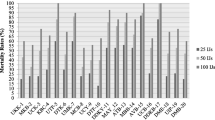Abstract
Six genera of bacteria: Serratia, Providentia, Enterobacter, Aeromonas, Cedecea and Bacillus were isolated from field-collected G. pallidipes. Four genera: Serratia, Providentia, Enterobacter and Aeromonas were isolated from insectary-reared Glossina morsitans morsitans. All bacteria except, Bacillus spp. and Providentia alealifaciens were pathogenic for teneral G. m. morsitans. Bacteria isolated from insectary-reared tsetse were more pathogenic than those isolated from the field. Fungi of three genera were also isolated from field-collected adult G. pallidipes, Penicillium, Aspergillus and Fusarium. Five genera, Aspergillus, Penicillium, Rhizopus, Mucor and Trichoderma were isolated from field-collected G. pallidipes pupae. The fungi, however, were only mildly pathogenic for adult tsetse and were not pathogenic for pupae.
Résumé
Six genres de bactéries: Serratia, Providentia, Enterobacter, Aeromonas, Cedecea et Bacillus ont été isolés à partir des mouches tsé-tsé adultes G. pallidipes récoltées sur le terrain. Quatre genres: Serratia, Providentia, Enterobacter et Aeromonas étaient isolés à partir de G. m. morsitans élevés à l’insectarium. Les testes de pathogénicité ont révelé que la pluspart des bactéries, à l’exception de Bacillus spp et Providentia alcalifaciens, étaient très pathogènes aux jeunes mouches tsé-tsé. Les bactéries isolées à partir des mouches tsé-tsé élevées à l’insectarium étaient très pathogènes que celles isolées des mouches tsé-tsé récoltées sur le terrain. Trois genres de champignons ont été isoles à partir des adultes de G. pallidipes récoltés sur le terrain. Ce sont Penicillium, Aspergillus et Fusarium. Cinq genres: Aspergillus, Penicillium, Rhizopus, Mucor et Trichoderma été isolés a partir des pupes de G. pallidipes récoltées sur le terrain. Toutefois, les champignons ont montré une très faible pathogènicité aux mouches tsé-tsé adultes et étaient non pathogèns aux pupes.
Similar content being viewed by others
References
Carlberg G. (1986) Bacillus thuringiensis and microbial control of flies. Mircern J. 2, 267–274.
Calberg G., Kihamia C. M. and Minjas J. (1985) Microbial control of flies in latrines in Dar-es-Salaam with a Bacillus thuringiensis (serotype I) preparation, Muscabac. Mircern J. 1, 33–44.
Goldberg L. J. and Margalit J. (1977) A bacterial spore demonstrating rapid larvicidal activity against Anopheles sergentii, Urantaenia unguiculata, Culex univittatus, Aedes aegypti and Culex pipiens. Mosq. News 37, 355–358.
Gruvel J. (1970) Elevagede G. tachinoides W. dans les conditions tropicales au Tchad. Proc. 1st. Symp. on Tsetse Fly Breeding under Laboratory Conditions andits Practical Application. Lisbon, 22–23 April, 1969, pp.117–123.
Kaaya G. P. (1989) Glossina morsitans morsitans: Mortalities caused in adults by experimental infection with entomopathogenic fungi. Acta Trop. 46, 107–114.
Kaaya G. P. and Darji N. (1989) Mortality in adult tsetse, Glossina morsitans morsitans caused by entomopathogenic bacteria. J. Invert. Pathol. 54, 32–38.
Kaaya G. P. and Okech M. A. (1990) Horizontal transmission of mycotic infection in adult tsetse, Glossina morsitans morsitans. Entomophaga (in press).
Lacey L. A., Escaffre H., Philippon B., Seketeli A. and Guillet P. (1982) Large river treatment with Bacillus thuringiensis (H-14) for the control of Simulium damnosum s.l. in the Onchocerciasis Control Programme. Tropenmed. Parasitol. 33, 97–101.
Nobre G. and Santos A. M. T. (1970) The use of antibiotics in artificial breeding of Glossina morsitans: A bacteriological study. Proc. 1st Int. Symp. on Tsetse Fly Breeding under Laboratory Conditions and its Practical Application, Lisbon, 22–23 April 1969, pp. 335–340.
Oliveira J. C. and Nobre G. (1970) Bacteriological and mycological study of a laboratory-bred Glossina colony. Proc. 1st Int. Symp. on Tsetse Fly Breeding under Laboratory Conditions and its Practical Application. Lisbon, 22–23 April 1969, pp. 341–348.
Poinar G. O., Jr., Wassink H. J. M., Leegwater Van den Linden E. M. and Van der Geest L. P. S. (1979) Serratia marcescens as a pathogen of tsetse flies. Acta Trop. 36, 223–227.
Roubaud E. and Treillard M. (1935) Un coccobacille pathogène pour les mouches tsétsé. C. R. Acad. Sci. (Paris) 201, 304–306.
Singer S. (1980) Bacillus sphaericus for the control of mosquitoes. Biotechnol. Bioeng. 22, 1335–1355.
Vey A. (1971) Recherches sur les champignons pathogènes pour les glossines. Etudes sur Glossina fusca congolensis Newst. et Evans en République Centrafricaine. Rev. Elev. Méd. Vét. Pays Trop. 24, 577–579.
Author information
Authors and Affiliations
Rights and permissions
About this article
Cite this article
Kaaya, G.P., Okech, M.A. Microorganisms Associated with Tsetse in Nature: Preliminary Results on Isolation, Identification and Pathogenicity. Int J Trop Insect Sci 11, 443–448 (1990). https://doi.org/10.1017/S1742758400012868
Received:
Published:
Issue Date:
DOI: https://doi.org/10.1017/S1742758400012868
Key Words
- Glossina morsitans morsitans
- G. pallidipes
- Serratia
- Providentia
- Enterobacter
- Cedecea
- Bacillus
- Penicillium
- Aspergillus
- Fusarium
- Rhizopus
- Mucor
- Trichoderma
- pathogenicity




